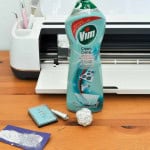How To Sharpen A Cricut Blade
Use household items to sharpen the edge of your dull Cricut fine-point blade.
Cost: $2
Equipment
- small pliers
- magnifying glass
Ingredients
- mild abrasive material like toothpaste or Vim cleanser
- dull fine point Cricut blade
- small piece paper
- natural light
Instructions
- First, apply a tiny amount of Vim cleanser to a piece of clean paper in a smear, and allow it to dry. You can hurry up the drying process by using a hairdryer. The cleanser will act as an abrasive to create a rough surface to sharpen the blade, almost like a very fine sandpaper.I did also experiment with toothpaste first, which was recommended in the video I linked above. The brand I was using didn't dry very well. It remained gummy on the paper, and I found it hard to work with. A different brand of toothpaste might have worked. I remembered that Vim cleanser can leave a dry powdery residue and decided to try it. It worked really well for me.
- Once the cleanser is dry, you are ready to sharpen the blade. First remove the blade from the quickswap tools housing. Even a dull blade is sharp enough to cut yourself, so do take care. You may want to use some pliers to remove it from the fine point blade housing.
- Find a spot next to a window, with good natural light. You may also like to use some magnifying glasses. Even an inexpensive one from the dollar store will help you see the blade edge more clearly.Holding the blade in your fingers, or with some small pliers, drag the blade away from the cutting edge at the same 45 degree angle as the cutting edge. Do this about 15 times on each side of the blade. Take care to hold the blade at the same angle as the existing blade edge. You can use a magnifying glass to look at your blade as you go. This will help ensure the angle is working and the blade is being sharpened.
- When you are finished you can make a test cut, and insure you have a sharp blade. If not, you can continue to sharpen it until it makes nice clean cuts again.
